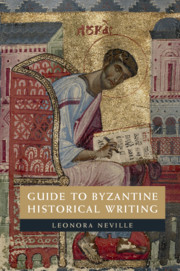Book contents
- Frontmatter
- Dedication
- Contents
- Acknowledgments
- Introduction
- Byzantine Historical Texts
- 1 Theophylakt Simokatta
- 2 Paschal Chronicle
- 3 George Synkellos
- 4 Chronicle of Theophanes
- 5 Patriarch Nikephoros
- 6 Scriptor Incertus de Leo V
- 7 Chronicle of 811
- 8 Megas Chronographos
- 9 George the Monk
- 10 Peter of Alexandria
- 11 Genesios
- 12 Theophanes Continuatus
- 13 Constantinian Excerpts
- 14 John Kaminiates
- 15 Symeon the Logothete
- 16 Leo the Deacon
- 17 Chronicle of Monemvasia
- 18 Chronicon Bruxellense
- 19 Psellos
- 20 John Xiphilinos
- 21 Michael Attaleiates
- 22 John Skylitzes and Scylitzes Continuatus
- 23 George Kedrenos
- 24 Nikephoros Bryennios
- 25 Anna Komnene
- 26 John Kinnamos
- 27 John Zonaras
- 28 Constantine Manasses
- 29 Michael Glykas
- 30 Eustathios of Thessaloniki
- 31 Joel
- 32 Niketas Choniates
- 33 George Akropolites
- 34 Theodore Skoutariotes
- 35 George Pachymeres
- 36 Nikephoros Gregoras
- 37 Ephraim
- 38 Constantine Akropolites the Grand Logothete
- 39 Chronicle of Morea
- 40 Nikephoros Kallistos Xanthopoulos
- 41 John VI Kantakouzenos
- 42 Michael Panaretos
- 43 Chronicle of Ioannina
- 44 Chronicle of Tocco
- 45 John Kananos
- 46 John Anagnostes
- 47 Leontios Machairas
- 48 Sylvester Syropoulos
- 49 Doukas
- 50 George Sphrantzes
- 51 Michael Kritovoulos
- 52 Laonikos Chalkokondyles
- Appendix A Time Periods Covered in the Histories
- Appendix B Timeline of Authors’ Lives
32 - Niketas Choniates
from Byzantine Historical Texts
Published online by Cambridge University Press: 14 June 2018
- Frontmatter
- Dedication
- Contents
- Acknowledgments
- Introduction
- Byzantine Historical Texts
- 1 Theophylakt Simokatta
- 2 Paschal Chronicle
- 3 George Synkellos
- 4 Chronicle of Theophanes
- 5 Patriarch Nikephoros
- 6 Scriptor Incertus de Leo V
- 7 Chronicle of 811
- 8 Megas Chronographos
- 9 George the Monk
- 10 Peter of Alexandria
- 11 Genesios
- 12 Theophanes Continuatus
- 13 Constantinian Excerpts
- 14 John Kaminiates
- 15 Symeon the Logothete
- 16 Leo the Deacon
- 17 Chronicle of Monemvasia
- 18 Chronicon Bruxellense
- 19 Psellos
- 20 John Xiphilinos
- 21 Michael Attaleiates
- 22 John Skylitzes and Scylitzes Continuatus
- 23 George Kedrenos
- 24 Nikephoros Bryennios
- 25 Anna Komnene
- 26 John Kinnamos
- 27 John Zonaras
- 28 Constantine Manasses
- 29 Michael Glykas
- 30 Eustathios of Thessaloniki
- 31 Joel
- 32 Niketas Choniates
- 33 George Akropolites
- 34 Theodore Skoutariotes
- 35 George Pachymeres
- 36 Nikephoros Gregoras
- 37 Ephraim
- 38 Constantine Akropolites the Grand Logothete
- 39 Chronicle of Morea
- 40 Nikephoros Kallistos Xanthopoulos
- 41 John VI Kantakouzenos
- 42 Michael Panaretos
- 43 Chronicle of Ioannina
- 44 Chronicle of Tocco
- 45 John Kananos
- 46 John Anagnostes
- 47 Leontios Machairas
- 48 Sylvester Syropoulos
- 49 Doukas
- 50 George Sphrantzes
- 51 Michael Kritovoulos
- 52 Laonikos Chalkokondyles
- Appendix A Time Periods Covered in the Histories
- Appendix B Timeline of Authors’ Lives
Summary
This detailed history covers 1118 to the early thirteenth century in a highly elusive and complex classicizing style. The History is the only surviving historical narrative from a Byzantine author for the last decades of the twelfth century, and is generally considered an indispensable source for the twelfth century and the history of the Third and Fourth Crusades. Several scholars, including Alexander Kazhdan and Alicia Simpson, view Choniates's text as stylistically distinct from previous historical writing in the empire, especially in terms of its tragic mood and the subtlety of its characterizations. At the same time, as Jonathan Harris has argued, Choniates remained deeply rooted in the Greek historiographical tradition. Choniates's writing is extraordinarily complex and he frequently plays with the multiple meanings of words as well as with readers’ expectations.
Choniates's text is a political and military history, covering the deeds of the Komnenian emperors and their successors beginning in 1118 through the sack of Constantinople in 1204 in the Fourth Crusade – an event to which the author was an eyewitness. The reign of John (1118– 1143) is treated relatively briefly, and the story increases in detail for the reigns of Manuel (1143– 1180) and his successors. The manuscript tradition preserves two versions of the history. Although it narrates events through spring 1205, first version of the History was mostly written before the conquest of the city, while Choniates was working for the imperial government. This first version of the History is shorter and less critical toward the emperors it depicts, especially Alexios III (1195– 1203). The second, revised version, which Choniates revised in exile after 1204, is longer, more moralizing and cynical, and is much more critical of emperors and common citizens. It covers the years 1118 through 1206. The less accusatory first version was probably written in the court of Alexios III, where a negative portrait of the reigning emperor would have been impolitic. The second version offers criticism as a means of explaining the disaster of 1204.
Information
- Type
- Chapter
- Information
- Guide to Byzantine Historical Writing , pp. 219 - 225Publisher: Cambridge University PressPrint publication year: 2018
